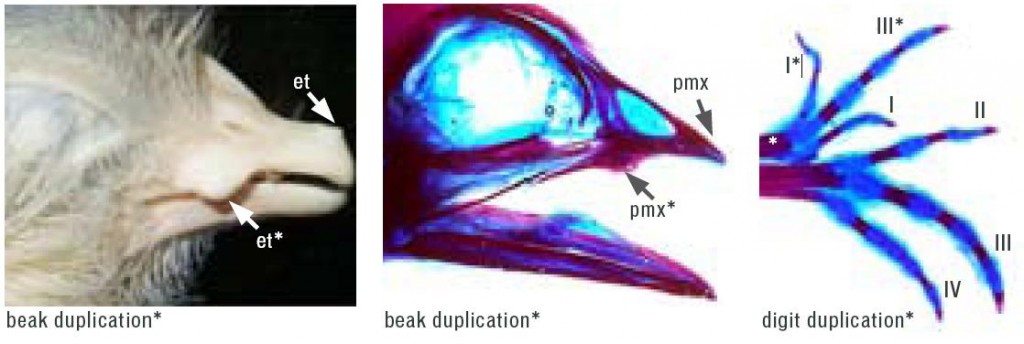March 15, 2010
The Canadian Institutes of Health Research (CIHR), the Government of Canada’s agency responsible for funding health research, recently funded 401 out of 2,186 applications Canadawide for operating grants. The success rate of obtaining one of these grants is just 18 percent. UBC Dentistry researchers Dr. Joy Richman and Drs. Donald Brunette and Douglas Waterfield not only received grants, but both applications were ranked number one by their respective peer review committees: Developmental Biology and Biomedical Engineering.
Dr. Joy Richman Secures Five-Year Funding to Research Inherited Birth Defects
Ranked as the number one application by the Developmental Biology peer review committee, Dr. Joy Richman’s research, titled “Molecular Controls of Jaw Identity and Limb Patterning,” has been awarded five-year funding—just over $907,000—from the CIHR.
In previous work, Richman unexpectedly found that the levels of retinoic acid (RA), a vitamin A derivative, and bone morphogenetic protein (BMP) are essential factors in jaw development. Tweaking these two molecules in early chicken embryos had a dramatic effect: the side of the face (cheek bones) was transformed to the centre of the face, essentially duplicating the upper beak! This experiment opened a window into the black box of facial development, since it was possible to jumpstart the process of face development and study its molecular consequences. Richman is now in the process of connecting the dots between molecules and intricately patterned facial bones. The most critical genes needed for forming certain parts of the face will be determined, as well as how they interact with each other.

Chicken embryo showing beak duplication and digit duplication.
In the present application, she explains, “We are focusing on a secreted protein that previously had not been studied in great detail and was not connected to facial development. Our molecular work had shown that this protein was strongly turned on in the beak experiment.” Putting the gene for this protein into the embryo was the next step, and Richman found that it was able to duplicate not only the beak, but also the digits of the limb. “This is exactly the kind of protein we would like to study, since it impacts many aspects of skeletal patterning. We now want to manipulate the levels of this protein in the early chicken embryo to determine its roles in shaping the skeleton of the limbs and face.”
Richman is optimistic: “Our work will not only shed light on inherited birth defects that affect the upper face, such as cleft lip and midline clefts, but also will help us to understand disturbances in the number of digits in the hands or feet.” Congenital anomalies affect 1 to 2 percent of all newborns and, of these, 10 percent affect the upper extremities. Cleft lip, with or without cleft palate, affects one in 700 babies. Moreover, face and limb deformities often occur in conjunction with each other due to common molecular signalling. In order to correct face and digit abnormalities, multiple surgeries are required, often followed by expensive dental or orthopedic treatments. It will be possible to use the knowledge gained from this research to prevent or decrease the severity of these anomalies.
For more information about Dr. Joy Richman, click here.
Drs. Donald Brunette and Douglas Waterfield Awarded Grant to Study the Effects of Surface Topography
Just over $685,000 has been allocated over five years to professor of oral biology Dr. Donald
Brunette and associate professor Dr. Douglas Waterfield for their research titled “Regulation
of Cell Behaviour on Implants by Surface Topography.” Their project ranked as the number one application to the Biomedical Engineering peer review committee for the CIHR’s Open Operating Grant Program.
Artificial implants are now used in a host of applications, including hip joints, catheters, heart valves and dental implants. The shape of the implant surface—that is, its topography—at the micrometre and nanometre scale has been found to influence cell and tissue responses to it. Current knowledge of how cells may be specifically controlled by topography is limited, however, which compromises the ability to develop improved surfaces. Under more-or-less ideal conditions, dental implant failure rates can be as little as 1 to 2 percent. But dental and other implants are now being employed in more challenging situations such as sites with poor bone quality, and failure rates can approach 30 percent depending on risk factors.

Electron micrographs of macrophages (M) adapting to sandblasted/acid-etched (SLA) surface topography, replicated in epoxy and coated with titanium. Ti = titanium coating, F = overlying layer of fibroblasts, Nu = nucleus. For a full report, see B. Chehroudi et al, Journal of Biomedical Materials Research (July 2009).
Brunette and Waterfield’s proposal will study the effects of surface topography on four types of cells that often contact implants: fibroblasts, epithelium, bone cells and macrophages. Using sophisticated methods of microfabrication and nanofabrication, novel and precisely characterized surfaces will be produced and examined for their effects on cell structure, migration and cell-cell interactions, as well as gene and cell signalling activities.
Brunette stresses that particular attention will be focused on the macrophage, as this cell orchestrates the body’s response to foreign bodies such as implants. The intent is to develop surfaces that induce macrophages to promote healing rather than destructive inflammation.
“Our past work has been used to modify some types of dental implants, and we anticipate the proposed work will lead to the rational, cell behaviour-based design of specific engineered surfaces that improve implant tissue integration for multiple clinical applications,” Brunette explains. “Improved surfaces will enable faster integration of implants with bone or other tissues, as well as enable implants to be used in situations that currently have a high risk of failure.”
For more information about Dr. Donald Brunette, click here.